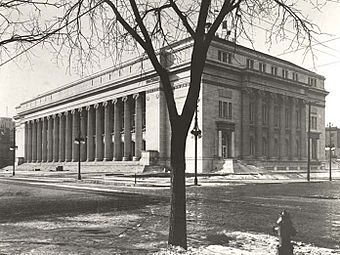Byron White United States Courthouse facts for kids
Quick facts for kids |
|
|
U.S. Post Office and Federal Building
|
|

United States Federal Courthouse in Denver, Colorado, 1916
|
|
| Location | 18th and Stout Sts., Denver, Colorado |
|---|---|
| Area | 2 acres (0.81 ha) |
| Built | 1916 |
| Architect | Tracy, Swartwout & Litchfield; Hedden Construction Co. |
| Architectural style | Classical Revival |
| NRHP reference No. | 73000470 |
| Added to NRHP | March 20, 1973 |
The Byron White United States Courthouse is a very important building in Denver, Colorado. It's where the United States Court of Appeals for the Tenth Circuit holds its sessions. This court helps decide big legal cases.
The building was finished between 1910 and 1916. In 1973, it was added to the National Register of Historic Places as the "U.S. Post Office and Federal Building." Later, in 1994, it was renamed to honor Byron White (1917–2002). He was a famous U.S. Supreme Court Justice from Fort Collins, Colorado.
Contents
History of the Courthouse Building
The Byron White U.S. Courthouse was designed in a grand style called Neo-Classical. This design was popular in the eastern United States. Its large size and elegant look showed how important and official the building was. It even inspired other public buildings in Denver.
By 1900, Denver was a busy city, important for travel and business in the West. The old U.S. Post Office, built in 1893, was already too small. So, people in Denver wanted a new, bigger building for the Post Office and Federal Courts.
Permission for a new building was given in 1903. But money for it wasn't set aside until 1908. In 1909, James Knox Taylor, who was in charge of government architecture, chose architects Tracy, Swartwout, and Litchfield from New York to design the building. This was special because usually government architects designed these buildings. But a law called the Tarsney Act allowed private architects to be chosen through design contests. This helped make public buildings more beautiful.
Construction started in 1910. But it was slow because there wasn't enough money. An extra $400,000 was added thanks to Joseph H. Harrison, the Denver Postmaster, who worked hard in Washington, D.C. The building finally opened in January 1916.
Amazing Architecture and Design
This courthouse is a great example of Neoclassical architecture. This style was very popular for federal buildings around 1900. The building takes up a whole city block in downtown Denver and is four stories tall. It has a balanced design, classic details, and a very impressive look.
The outside of the courthouse is covered in beautiful Yule Marble from Colorado. This same marble was used for famous buildings like the Lincoln Memorial in Washington, D.C. The building sits on a strong, stone base. Large stairs lead up to the main entrance on Stout Street. This entrance has sixteen tall, three-story columns. These columns are decorated with eagles.
Above the main entrance, there's a decorative band called a frieze. It has names of cities carved into it. Cities to the east of Denver are on the east side, and cities to the west are on the west. This shows how mail traveled across the country. The marble walls next to the columns have the names of past U.S. postmasters general carved into them.
Other sides of the building also have special sayings. On Eighteenth Street, it says, "The law causes wrong or injury to no one." On the Nineteenth Street side, it says, "To no one shall we deny justice, nor shall we discriminate in its application." There are also marble seats with sayings about work and rest.
Inside, the main lobby goes across the whole building. It has a colorful terrazzo floor and a high, arched ceiling. The walls are covered in marble and have the names of Pony Express riders. The U.S. Court of Appeals is on the second floor. The Law Library, now Courtroom Four, has beautiful carved oak panels. One courtroom, District Courtroom A, still has its original black velvet curtains with gold trim.
The courthouse also has amazing artwork. Two stone sculptures of Rocky Mountain sheep sit at the southwest entrance. These were made by Denver artist Gladys Caldwell Fisher in 1936. Inside, there are four large paintings by Herman Schladermundt. These paintings, completed in 1918, show themes like "Postal Service" and "Labor is Great Producer of Wealth."
The building had some changes in the 1950s and 1960s. But from 1992 to 1994, many of these changes were undone. The building was carefully restored to its original beauty for the United States Court of Appeals for the Tenth Circuit. This restoration won many awards.
Important Events in the Courthouse's History
- 1893: The Tarsney Act is passed, allowing the government to hire private architects.
- 1908-1909: Money is set aside, land is bought, and the design for the new Post Office and Federal Building is created.
- 1910-1916: The U.S. Post Office and Federal Building is built.
- 1918: Four large paintings by Herman T. Schladermundt are put in the lobby.
- 1936: Stone sculptures of Rocky Mountain sheep by Gladys Caldwell Fisher are installed.
- 1950s: The building gets major updates and changes.
- 1962-1966: The U.S. Postal Service uses the building and makes big changes for their needs.
- 1973: The U.S. Post Office and Federal Building is added to the National Register of Historic Places.
- 1992-1994: The U.S. General Services Administration does a huge renovation and restoration of the building.
- 1994: The building is renamed and dedicated as the Byron White United States Courthouse.
- 1994-1997: The restoration of the Byron White United States Courthouse receives many awards.
Gallery
Images for kids





